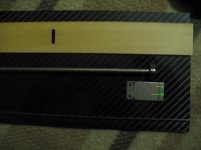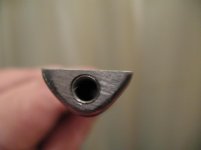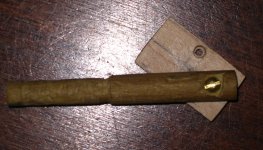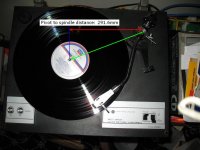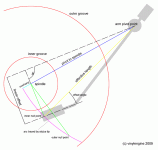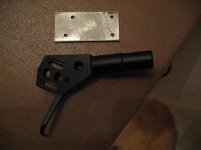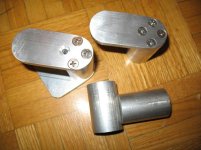Hi ,
See here for a Tufnol density list(in the same range as some of the heavier hardwoods(ebony, snakewood, ironwood....):
Tufnol Composites | Tufnol Laminates | Laminated Plastics | Fabric Laminates | Industrial Laminates
one of many sources:
Hi-Wire Limited Tufnol Tubes
@ Ken: The combination you mentioned sounds like a good start 🙂
@ Gabor: If you try to drill a hole in any type of resin impregnated fabric (or paper) you will curse me after a little while... get some readily available tube material, it'll save you a lot of time. And if you REALLY need a super light arm, I'd recommend Bamboo(I'm not kidding). I've build quite a few arms with wands based on Bamboo and you can get the eff. mass down to 5 grams(!).
Good night,
Frank
See here for a Tufnol density list(in the same range as some of the heavier hardwoods(ebony, snakewood, ironwood....):
Tufnol Composites | Tufnol Laminates | Laminated Plastics | Fabric Laminates | Industrial Laminates
one of many sources:
Hi-Wire Limited Tufnol Tubes
@ Ken: The combination you mentioned sounds like a good start 🙂
@ Gabor: If you try to drill a hole in any type of resin impregnated fabric (or paper) you will curse me after a little while... get some readily available tube material, it'll save you a lot of time. And if you REALLY need a super light arm, I'd recommend Bamboo(I'm not kidding). I've build quite a few arms with wands based on Bamboo and you can get the eff. mass down to 5 grams(!).
Good night,
Frank
Hello
You right! Only problem I have no access (to work with wood) to use wood shaft. So I have to use material usually commercial arms built.
Like many people also test different shaft material to learn ... To me hobby not just listening music.
I use right now Shure V15 Type III super track plus but I just purchased stylus to my V type and type IV. Also I have Ortofon OM 20 I'll upgrade it for 40. Have a Signet 5 and 9 but both need stylus and other cheap stuff.
Why the arm has to be ultra light? First of all I don't know what belong to ultra light or normal or heavy.
To be honest the advise I get I go after that a 12" arm shaft about 15-17gr (just the pipe or tube).
Another reason I plan to make a 15" arm, of course I start with a shorter arm.
It is always possible to ad weight (dumping material like oil, silicon etc)to the arm but when is ready and to heavy that is a big bu-bu.
Like you I didn't read all the way all has been posted..
I came from another arm design here. When I sow these right away I felt in love with these idea.
I see similar arm suspension with out the magnet 20 years a go I did like the idea also but the owner didn't let me to eye ball it.
I will also test the pivot type arm first I started in case....
In case if I don't like these design it will be because I messed up!
These is a proven tonearm. So much some panda man sell (these idea or design) over $1000 on Ebay.
Please do not worried about, I do respect people who make think available to us DIY-ers even if I'm not 100% satisfied on the end!
I built Nelson Pass Aleph30, it was not the best amp I ever heard but that not mean bad design!
I have several other Pass amp half ready or tested. Thanks to PAPA..
I think that way I like to get all the material can be useful available after I have time to test them.
Sometimes my eye bigger than my stomach that is true also.
That is how I grow up. I do not want to change now, I'm over 40.
Greetings Gabor
You right! Only problem I have no access (to work with wood) to use wood shaft. So I have to use material usually commercial arms built.
Like many people also test different shaft material to learn ... To me hobby not just listening music.
I use right now Shure V15 Type III super track plus but I just purchased stylus to my V type and type IV. Also I have Ortofon OM 20 I'll upgrade it for 40. Have a Signet 5 and 9 but both need stylus and other cheap stuff.
Why the arm has to be ultra light? First of all I don't know what belong to ultra light or normal or heavy.
To be honest the advise I get I go after that a 12" arm shaft about 15-17gr (just the pipe or tube).
Another reason I plan to make a 15" arm, of course I start with a shorter arm.
It is always possible to ad weight (dumping material like oil, silicon etc)to the arm but when is ready and to heavy that is a big bu-bu.
Like you I didn't read all the way all has been posted..
I came from another arm design here. When I sow these right away I felt in love with these idea.
I see similar arm suspension with out the magnet 20 years a go I did like the idea also but the owner didn't let me to eye ball it.
I will also test the pivot type arm first I started in case....
In case if I don't like these design it will be because I messed up!
These is a proven tonearm. So much some panda man sell (these idea or design) over $1000 on Ebay.
Please do not worried about, I do respect people who make think available to us DIY-ers even if I'm not 100% satisfied on the end!
I built Nelson Pass Aleph30, it was not the best amp I ever heard but that not mean bad design!
I have several other Pass amp half ready or tested. Thanks to PAPA..
I think that way I like to get all the material can be useful available after I have time to test them.
Sometimes my eye bigger than my stomach that is true also.
That is how I grow up. I do not want to change now, I'm over 40.
Greetings Gabor
That makes a lot of sense and I apologise for shoving my nose in when it is I who - in the light of Frank's post above - am clearly wrong! My arm needs are based on a very heavy and low compliance cartridge, an Io which came from the first few built by Kondo San. These needs are exactly the opposite of yours. I can use high mass to a point with this cartridge. But it is interesting and telling that Kondo advised me in an email that his favourite arm was a ......Schroeder!!!
My skills in metalwork are minimal and I have no machining equipment, so I too have to stick to 'adopting and adapting' pieces of other equipment. [I am at present making a high mass unipivot arm using solid carbon, silicon carbide tubing, and some bits from a totally broken FR arm, including the elevation base.
Hope all goes well with your work!
My skills in metalwork are minimal and I have no machining equipment, so I too have to stick to 'adopting and adapting' pieces of other equipment. [I am at present making a high mass unipivot arm using solid carbon, silicon carbide tubing, and some bits from a totally broken FR arm, including the elevation base.
Hope all goes well with your work!
Hello
Just received the carbon fibre tubes. They are really nice and all the way carbon just a thin lacquer outside for UV etc protection.
They are very light and stiff even the 0.5 wall thickness stiff enough for arm shaft.
I just wasted my time and money on golf club shaft.
The problem with golf club shaft one side 1/2" another side 1". If you try to remove weight from inside of the pipe a lot of headache..
Well worth that investment for all 3 tube aluminum arrow shaft, titanium tube and these carbon fibre tube.
Now until I do not test them I do not plan to search for other arm shaft material .
Al do the bamboo stick is great idea to.
That I can get here in Toronto at China town but only if I don't find these materials I have at hand satisfactory.
Now is time to work but the winter is back unfortunately..
You do not need huge metal skill to do these I've done yesterday.
Can someone let me know when I use 100% straight arm aproximately the cartridge angle in mm please.🙂 I have acces to drill holes only.
Greetings Gabor
Just received the carbon fibre tubes. They are really nice and all the way carbon just a thin lacquer outside for UV etc protection.
They are very light and stiff even the 0.5 wall thickness stiff enough for arm shaft.
I just wasted my time and money on golf club shaft.
The problem with golf club shaft one side 1/2" another side 1". If you try to remove weight from inside of the pipe a lot of headache..
Well worth that investment for all 3 tube aluminum arrow shaft, titanium tube and these carbon fibre tube.
Now until I do not test them I do not plan to search for other arm shaft material .
Al do the bamboo stick is great idea to.
That I can get here in Toronto at China town but only if I don't find these materials I have at hand satisfactory.
Now is time to work but the winter is back unfortunately..
You do not need huge metal skill to do these I've done yesterday.
Can someone let me know when I use 100% straight arm aproximately the cartridge angle in mm please.🙂 I have acces to drill holes only.
Greetings Gabor
Attachments
Hello,
I have thoroughly read all (nearly 90) pages of this thread, since I intend to built my clone of the Schroeder arm too. I have gathered all important information and downloaded tens of photos for studying. There are a couple of things that I would like to clarify, since I have no clear view for them:
First, and more important, is how the thread is attached on its lower end (ie, the arm aluminum back part - I don't know haw this part is called). I have three ideas on how: either with a thin plate with a small hole on top of the magnet, or with the thread super-glued on the center point of the top surface of the magnet, or using a magnet with a hole and passing the thread through the magnet with a knot on the lower surface of it. What is the right way to do this?
Secondly, I wonder if the two magnets have to be the same diameter, or the lower (steady) magnet could be larger than the upper one.
And one more question - what is the diameter of the aluminum cylinder where the upper magnet is fitted? Is there a common dimension or it is dependent of the diameter of the armwand?
Regards,
Evangelos
I have thoroughly read all (nearly 90) pages of this thread, since I intend to built my clone of the Schroeder arm too. I have gathered all important information and downloaded tens of photos for studying. There are a couple of things that I would like to clarify, since I have no clear view for them:
First, and more important, is how the thread is attached on its lower end (ie, the arm aluminum back part - I don't know haw this part is called). I have three ideas on how: either with a thin plate with a small hole on top of the magnet, or with the thread super-glued on the center point of the top surface of the magnet, or using a magnet with a hole and passing the thread through the magnet with a knot on the lower surface of it. What is the right way to do this?
Secondly, I wonder if the two magnets have to be the same diameter, or the lower (steady) magnet could be larger than the upper one.
And one more question - what is the diameter of the aluminum cylinder where the upper magnet is fitted? Is there a common dimension or it is dependent of the diameter of the armwand?
Regards,
Evangelos
Gabor - I think I am right in saying that the geometry for schroeder arms is exactly based on Baerwald Alignment for 222mm, arm pivot to platter spindle distance.
This gives an offset angle for the cartridge of 22.986deg (23deg is close enough).
Effective length = 239.296mm
Overhang = 17.296mm
If these figures do not provide an answer for you, please try and explain more about the angle you are needing.(angles are not measured in mm so bit confused by your question)
Regards
Ken
This gives an offset angle for the cartridge of 22.986deg (23deg is close enough).
Effective length = 239.296mm
Overhang = 17.296mm
If these figures do not provide an answer for you, please try and explain more about the angle you are needing.(angles are not measured in mm so bit confused by your question)
Regards
Ken
Hello Ken
Thank you
I asked the difference (angle) between the two hole on the head shell because I use 100% straight arm. Including the head shell is straight to.
I had a Pioneer head shell from straight arm and after that I drill the two hole for cartridge mounting. I did made the holes larger so I can shift the cartridge if there is a need for adjustment.
I can't use your formula because I'll build a 12" arm and one 15".
I will see, now I wait on the magnets also I have more work to be done on the suspension.
I build two arm the same time.
All hand work, very slow process.
Greetings Gabor
Thank you
I asked the difference (angle) between the two hole on the head shell because I use 100% straight arm. Including the head shell is straight to.
I had a Pioneer head shell from straight arm and after that I drill the two hole for cartridge mounting. I did made the holes larger so I can shift the cartridge if there is a need for adjustment.
I can't use your formula because I'll build a 12" arm and one 15".
I will see, now I wait on the magnets also I have more work to be done on the suspension.
I build two arm the same time.
All hand work, very slow process.
Greetings Gabor
I build two arm the same time.
All hand work, very slow process.
Greetings Gabor
Go ahead

Regards zeoN_Rider
Hi Gabor, I see what you are trying to do.
If you go to vinylengine.com there is a lot of data on 12" arms geometry etc.
If you establish your spindle to arm pivot distance, you can base it on what other arms use, you can enter this distance into a program on that site and it will give you the effective length, offset angle etc for baerwald and other alignments. This is how I concluded the schroder is based on Baerwald alignment because the program returned results that exactly match those listed for the schroder's. This is presuming the source for the schroder geometry in their data base is acurate of course.
Perhaps if Berlinta is around he could confirm the figures on vinyl engine?
Anyway, go look and have a try with the alignment program, it even lets you print out an alignment gauge which I have used on my Roksan arm with great effect. To my ear, with the cartridge I was using, it gave better results than the gauge supplied with the arm.
Good luck building
Ken
If you go to vinylengine.com there is a lot of data on 12" arms geometry etc.
If you establish your spindle to arm pivot distance, you can base it on what other arms use, you can enter this distance into a program on that site and it will give you the effective length, offset angle etc for baerwald and other alignments. This is how I concluded the schroder is based on Baerwald alignment because the program returned results that exactly match those listed for the schroder's. This is presuming the source for the schroder geometry in their data base is acurate of course.
Perhaps if Berlinta is around he could confirm the figures on vinyl engine?
Anyway, go look and have a try with the alignment program, it even lets you print out an alignment gauge which I have used on my Roksan arm with great effect. To my ear, with the cartridge I was using, it gave better results than the gauge supplied with the arm.
Good luck building
Ken
Gabby, please...
...you continue to make things more complicated than they need to be. I'll give you the numbers, but you really need to simplify all of this. The easiest solution is as I suggested. Use a Schroder style headshell. Basically go to Canuck Tire and buy a piece of wood dowel that fits inside your desired tube. cut it about 2-1/2" in length. Use a sharp knife to get 2 flat sides opposite each other. Glue it (or use a screw through the tube into the dowel. Drill a hole for a fastener at approximately the effective length of the arm. Now attach the headshell plate to the arm/dowel assembly using a screw or bolt or whatever.Mount a cartridge.Tighten the single screw that allows the plate to pivot. Get a protractor. Don't worry about the overhang. Adjust the headshell to that the stylus hits the appropriate mark on the protractor. Now adjust the headshell plate to allow the cartridge front to align with the radial lines on the protractor.Done.This is very simple to do.
If you have no access to a woodshop, I did one with a hand drill and a small handsaw. You can do the same thing with aluminum, just it takes a lot longer to do.
Ok some math. If you insist on making custom headshells for this project, here's how you can do it. Let's assume you want to have the same geometry as a SAEC WE-308:
From high school: sinϴ = opposite/hypotenuse (I'll call these 'r', and 'x')
cosϴ = adjacent/hypotenuse (and here I'll call adjacent 'y').
we know that 'r'=1/2", ϴ = 12°
so y= 1/2* cosϴ=.48907" or 12.424 mm
and x=1/2*sinϴ=.10396" or 2.6404 mm
To me there is no way you can accomplish this. You will still have to "twist" the cartridge in the headshell, something you stated elsewhere that you didn't want to do. If you use smaller machine screws in a straight "regular" headshell you can accomplish this with no need for any math or else just use the Schroder type. Because you want to try to use a 15" arm, I'll not comment on that, but a better choice is a 16" arm as many(well a few) were produced. Using the Shroder style headdshell takes the math out of everything.
Gabby, please quit sticking on these details. I know God is in the details, but this is ad nausea...it just goes on and on...
...you continue to make things more complicated than they need to be. I'll give you the numbers, but you really need to simplify all of this. The easiest solution is as I suggested. Use a Schroder style headshell. Basically go to Canuck Tire and buy a piece of wood dowel that fits inside your desired tube. cut it about 2-1/2" in length. Use a sharp knife to get 2 flat sides opposite each other. Glue it (or use a screw through the tube into the dowel. Drill a hole for a fastener at approximately the effective length of the arm. Now attach the headshell plate to the arm/dowel assembly using a screw or bolt or whatever.Mount a cartridge.Tighten the single screw that allows the plate to pivot. Get a protractor. Don't worry about the overhang. Adjust the headshell to that the stylus hits the appropriate mark on the protractor. Now adjust the headshell plate to allow the cartridge front to align with the radial lines on the protractor.Done.This is very simple to do.
If you have no access to a woodshop, I did one with a hand drill and a small handsaw. You can do the same thing with aluminum, just it takes a lot longer to do.
Ok some math. If you insist on making custom headshells for this project, here's how you can do it. Let's assume you want to have the same geometry as a SAEC WE-308:
- Overall length: 329mm
- Effective length: 270mm
- Overhang: 5mm
- Offset angle:12°
From high school: sinϴ = opposite/hypotenuse (I'll call these 'r', and 'x')
cosϴ = adjacent/hypotenuse (and here I'll call adjacent 'y').
we know that 'r'=1/2", ϴ = 12°
so y= 1/2* cosϴ=.48907" or 12.424 mm
and x=1/2*sinϴ=.10396" or 2.6404 mm
To me there is no way you can accomplish this. You will still have to "twist" the cartridge in the headshell, something you stated elsewhere that you didn't want to do. If you use smaller machine screws in a straight "regular" headshell you can accomplish this with no need for any math or else just use the Schroder type. Because you want to try to use a 15" arm, I'll not comment on that, but a better choice is a 16" arm as many(well a few) were produced. Using the Shroder style headdshell takes the math out of everything.
Gabby, please quit sticking on these details. I know God is in the details, but this is ad nausea...it just goes on and on...
Last edited:
Hello Nannok
With the Titanium tube I can't do the wood dowel because the inside diameter about 5mm only.
But basically I understood your advise and I follow that.
I do not want to go into any difficult math, very soon I'll get lost.
I need to find a good protractor.
My plan first I use a simple laminated board for plinth to test the arms. After when I get it right I'll make some measurement. That will let me know where the arm suspension goes. What size must be the plinth etc.
After I glue together 6-7 level Baltic birch for plinth.
If you know where I find a good protractor please let me know.
If I'm right usually the 9" tonearm use the same head shell like the 12", I think about S shaped tone arm and removable head shell.
So straight arm must have same or similar rule.
Greetings Gabor
With the Titanium tube I can't do the wood dowel because the inside diameter about 5mm only.
But basically I understood your advise and I follow that.
I do not want to go into any difficult math, very soon I'll get lost.
I need to find a good protractor.
My plan first I use a simple laminated board for plinth to test the arms. After when I get it right I'll make some measurement. That will let me know where the arm suspension goes. What size must be the plinth etc.
After I glue together 6-7 level Baltic birch for plinth.
If you know where I find a good protractor please let me know.
If I'm right usually the 9" tonearm use the same head shell like the 12", I think about S shaped tone arm and removable head shell.
So straight arm must have same or similar rule.
Greetings Gabor
Hi Gabor,
I really don't want to discourage you, but before you invest all this time and (hopefully modest) cost, you need to do a little homework. Your last post clearly shows that you don't seem to know about, or just understand the basic geometric requirements of tonearm design. If you are unable to do the research(vinyl engine has LOTS of info, John Elison's tonearm geometry excel sheet is simple to use too), please send the actual EFFECTIVE armlength(pivot to stylus distance) that you ended up with and I will provide the required figures for offset angle and pivot to spindle distance.
Btw, for a simple test, you don't need to glue any birch plywood boards together. A single, 30mm board will do just fine.
Cheers,
Frank
I really don't want to discourage you, but before you invest all this time and (hopefully modest) cost, you need to do a little homework. Your last post clearly shows that you don't seem to know about, or just understand the basic geometric requirements of tonearm design. If you are unable to do the research(vinyl engine has LOTS of info, John Elison's tonearm geometry excel sheet is simple to use too), please send the actual EFFECTIVE armlength(pivot to stylus distance) that you ended up with and I will provide the required figures for offset angle and pivot to spindle distance.
Btw, for a simple test, you don't need to glue any birch plywood boards together. A single, 30mm board will do just fine.
Cheers,
Frank
Hello Berlinta
Thank you very much!
For testing I'll use a piece of cheap board how you wrote. When I'm done with the tests I build a plinth from Baltic birch.
The first arm I'll test it will be 12" effective length. From the suspension to the needle..
I do tests because I have 3 diferent type of material for arm wand.
Titanium, carbon fibre, and aluminium arrow shaft.
Also I'll test different head shell (home made) material wood, titanium, carbon fibre, aluminium.
The head shell test I do after I set up the arm, that probably change the sound only because I plan to use same measurement for all head shell..
Greetings Gabor
Thank you very much!
For testing I'll use a piece of cheap board how you wrote. When I'm done with the tests I build a plinth from Baltic birch.
The first arm I'll test it will be 12" effective length. From the suspension to the needle..
I do tests because I have 3 diferent type of material for arm wand.
Titanium, carbon fibre, and aluminium arrow shaft.
Also I'll test different head shell (home made) material wood, titanium, carbon fibre, aluminium.
The head shell test I do after I set up the arm, that probably change the sound only because I plan to use same measurement for all head shell..
Greetings Gabor
Gabby, jump at Frank's (berlinta) offer! (sorry a little long)
Gabby, it is not everyday that a the designer of an original product offers to help:
The use of Frank's headshell design allows you to easily adjust the O/S, and allows you to try various alignments on your tonearm/cartridge system. Free to download alignment protractors and the Excel spreadsdheet Frank mentions are available there as well. I use the Oracle alignment protractor. It is a single point protractor, and I find it easy to use (I just ignore the straight line used to align the center of the tonearm pivot and the disk for proper alignment).
When I decided on a basic design for my arm, I adopted the basic parameters from the SAEC WE308 (which I did after I built it). With a small O/S of only 12°, and a very small O/H of 5 mm. My personal arm is actually slightly longer (approximately 308 effective length), but I use 2 mm screws for cartridge mounting and can adjust the angle while still having very good clamping force (using proper washers in slots intended for 3 mm).
About gluing material for a plinth, you can just use a piece of wood that can stand beside your 1229 turntable (most likely the rear left hand side would allow you to try the arm without taking apart the Dual). Worry about constructing a plinth for the Dual after your tonearm experiments are complete.
Regarding a headshell for a 9" tonearm, the actual angle depends on what the manufacturer has decided to use for an alignment (there are at least 3 "alignments" that I know of, perhaps there are more). This is why a Linn headshell does not provide good alignment for an arm that does not match its designer's preference in alignments, and it's basic parameters. You've spent too much money (how many headshells have you bought? What have you spent on only the headshells?) chasing the magic "universal" headshell for all alignments and all tonearm lengths. It simply does not exist.
With the considerable offer of help from Frank, I strongly suggest do exactly as he states, and you will end up with something very good. And wood can be used as a tonearm wand. Buy an oversized dowel and using something as simple as a hand drill, it can be sanded down to whatever is required to fit into the titanium tube.
I'll take a photo of what I did in less than an hour using crude hand tools.
Gabby, it is not everyday that a the designer of an original product offers to help:
I agree with Frank that it is your lack of understanding concerning Offset Angle (O/S), Overhang (O/H), and the various alignment geometries that are causing you all of the problems and all the questions. Frank's recommendation about the vinylengine site is exactly as I had suggested elsewhere previously.Hi Gabor,
I really don't want to discourage you, but before you invest all this time and (hopefully modest) cost, you need to do a little homework. Your last post clearly shows that you don't seem to know about, or just understand the basic geometric requirements of tonearm design. If you are unable to do the research (vinyl engine has LOTS of info, John Elison's tonearm geometry excel sheet is simple to use too), please send the actual EFFECTIVE armlength (pivot to stylus distance) that you ended up with and I will provide the required figures for offset angle and pivot to spindle distance.
Btw, for a simple test, you don't need to glue any birch plywood boards together. A single, 30mm board will do just fine.
Cheers,
Frank
The use of Frank's headshell design allows you to easily adjust the O/S, and allows you to try various alignments on your tonearm/cartridge system. Free to download alignment protractors and the Excel spreadsdheet Frank mentions are available there as well. I use the Oracle alignment protractor. It is a single point protractor, and I find it easy to use (I just ignore the straight line used to align the center of the tonearm pivot and the disk for proper alignment).
When I decided on a basic design for my arm, I adopted the basic parameters from the SAEC WE308 (which I did after I built it). With a small O/S of only 12°, and a very small O/H of 5 mm. My personal arm is actually slightly longer (approximately 308 effective length), but I use 2 mm screws for cartridge mounting and can adjust the angle while still having very good clamping force (using proper washers in slots intended for 3 mm).
About gluing material for a plinth, you can just use a piece of wood that can stand beside your 1229 turntable (most likely the rear left hand side would allow you to try the arm without taking apart the Dual). Worry about constructing a plinth for the Dual after your tonearm experiments are complete.
Hello Nannok
With the Titanium tube I can't do the wood dowel because the inside diameter about 5mm only.
But basically I understood your advise and I follow that.
I do not want to go into any difficult math, very soon I'll get lost.
I need to find a good protractor.
My plan first I use a simple laminated board for plinth to test the arms. After when I get it right I'll make some measurement. That will let me know where the arm suspension goes. What size must be the plinth etc.
After I glue together 6-7 level Baltic birch for plinth.
If you know where I find a good protractor please let me know.
If I'm right usually the 9" tonearm use the same head shell like the 12", I think about S shaped tone arm and removable head shell.
So straight arm must have same or similar rule.
Greetings Gabor
Regarding a headshell for a 9" tonearm, the actual angle depends on what the manufacturer has decided to use for an alignment (there are at least 3 "alignments" that I know of, perhaps there are more). This is why a Linn headshell does not provide good alignment for an arm that does not match its designer's preference in alignments, and it's basic parameters. You've spent too much money (how many headshells have you bought? What have you spent on only the headshells?) chasing the magic "universal" headshell for all alignments and all tonearm lengths. It simply does not exist.
With the considerable offer of help from Frank, I strongly suggest do exactly as he states, and you will end up with something very good. And wood can be used as a tonearm wand. Buy an oversized dowel and using something as simple as a hand drill, it can be sanded down to whatever is required to fit into the titanium tube.
I'll take a photo of what I did in less than an hour using crude hand tools.
Attachments
Hi Gabor,
If the effective length of your arm is exactly 12", the millimeter equivalent is 304,8mm. Lets round this off to the nearest millimeter. For an eff. l. of 305mm, the following figures can be derived for Baerwald alignment(0-points at 66 and 120,9mm):
Offset angle:17,84°
Pivot to spindle distance: 291.6mm
The overhang is (eff. l. minus p. to s. distance): 13,4mm
The resulting, tracing error related distorsions will remain below 0,5%
Make sure you get as close to these figures as you can. A deviation of only 0.3mm(!) or 0,3° is enough to put you in 9" arm territory(in terms of max. distorsion)
If in doubt, it's better to adjust the cartridge with a touch too much overhang or an ever so slightly smaller offset angle. Most people do not have tools that are precise enough or good enough an eyesight to tell the difference. But proper arm cartridge set up is another can of worms....
Good luck,
Frank
If the effective length of your arm is exactly 12", the millimeter equivalent is 304,8mm. Lets round this off to the nearest millimeter. For an eff. l. of 305mm, the following figures can be derived for Baerwald alignment(0-points at 66 and 120,9mm):
Offset angle:17,84°
Pivot to spindle distance: 291.6mm
The overhang is (eff. l. minus p. to s. distance): 13,4mm
The resulting, tracing error related distorsions will remain below 0,5%
Make sure you get as close to these figures as you can. A deviation of only 0.3mm(!) or 0,3° is enough to put you in 9" arm territory(in terms of max. distorsion)
If in doubt, it's better to adjust the cartridge with a touch too much overhang or an ever so slightly smaller offset angle. Most people do not have tools that are precise enough or good enough an eyesight to tell the difference. But proper arm cartridge set up is another can of worms....
Good luck,
Frank
Frank,
With the gracious offer you posted earlier, and the one above with details,#895.
You are hereby officially welcomed into the prestigious, Fellowship of Audio Designers (FAD) that have given their ideas and their talents to the DIY crowd, who humbly and affectionately look up to you. ie: Papa.
We need to give Frank an honorary title as we have given Nelson Pass. (Papa)
Frank if you have a preference...........speak now, or you may regret it. 😉
Heir Dr?
Mit vielen Dank im voraus,
Ron
With the gracious offer you posted earlier, and the one above with details,#895.
You are hereby officially welcomed into the prestigious, Fellowship of Audio Designers (FAD) that have given their ideas and their talents to the DIY crowd, who humbly and affectionately look up to you. ie: Papa.
We need to give Frank an honorary title as we have given Nelson Pass. (Papa)
Frank if you have a preference...........speak now, or you may regret it. 😉
Heir Dr?
Mit vielen Dank im voraus,
Ron
Hello Frank
Danke schön!🙂
First question to avoid the mistake - here the red or the green is the correct measurement?
Please let me know. If I can guess the red but I must found out the rest of the given measurement because the red alone not much.
I have to go to that site and study the angle- names etc.😀 Yes I have to do my home work.
Thank you very much!!!🙂
Greetings Gabor
Danke schön!🙂
First question to avoid the mistake - here the red or the green is the correct measurement?
Please let me know. If I can guess the red but I must found out the rest of the given measurement because the red alone not much.
I have to go to that site and study the angle- names etc.😀 Yes I have to do my home work.
Thank you very much!!!🙂
Greetings Gabor
Attachments
Hello
OK I found several answer to my questions.
I will study until I get the right all clear to me. Right now any way I'm busy with the arm suspension.
Look like I will need some precise took for angle measurement.
One more time thank you very much Frank!🙂
Greetings Gabor
OK I found several answer to my questions.
I will study until I get the right all clear to me. Right now any way I'm busy with the arm suspension.
Look like I will need some precise took for angle measurement.
One more time thank you very much Frank!🙂
Greetings Gabor
Attachments
Hello Herr Renron
Not bad, except that it should be "Herr"
My motive is to pass on what I know, not to show off what I know.
Sincerely,
Ralf
Heir Dr?
Not bad, except that it should be "Herr"
My motive is to pass on what I know, not to show off what I know.
Sincerely,
Ralf
Hello Nannok
I'm happy because the Linn head shell investment it was not waste of money.
It cost me $30 with shipping. I just measured the angle with online tool and I can use her.
Also what I made from titanium that plate close to 18 degree angle. If I drill 3mm holes I can shift that much the cartridge.
I like these type of head shell like your wood, I have some plan I do not want to change now. These titanium plate will be mounted on that piece I made for support with 2 screws. I can replaced with wood, aluminium, carbon fibre.
That not mean your idea is not good, please do not misunderstand!
I have a lot to thank you and I hope still I can count on your help.
There are some measurement from Frank not clear to me and I didn't find info on the net yet.
May be you can help with that if you would be so kind.
Thank you
Frank helped more than I can ever thank him!I work on the suspension , all hand work. Not even half ready but slowly will take (get in) shape. These material for two arm suspension.
Greetings Gabor
I'm happy because the Linn head shell investment it was not waste of money.
It cost me $30 with shipping. I just measured the angle with online tool and I can use her.
Also what I made from titanium that plate close to 18 degree angle. If I drill 3mm holes I can shift that much the cartridge.
I like these type of head shell like your wood, I have some plan I do not want to change now. These titanium plate will be mounted on that piece I made for support with 2 screws. I can replaced with wood, aluminium, carbon fibre.
That not mean your idea is not good, please do not misunderstand!
I have a lot to thank you and I hope still I can count on your help.
There are some measurement from Frank not clear to me and I didn't find info on the net yet.
May be you can help with that if you would be so kind.
Thank you
Frank helped more than I can ever thank him!I work on the suspension , all hand work. Not even half ready but slowly will take (get in) shape. These material for two arm suspension.
Greetings Gabor
Attachments
- Home
- Source & Line
- Analogue Source
- DIY Schroeder Tonearm?
